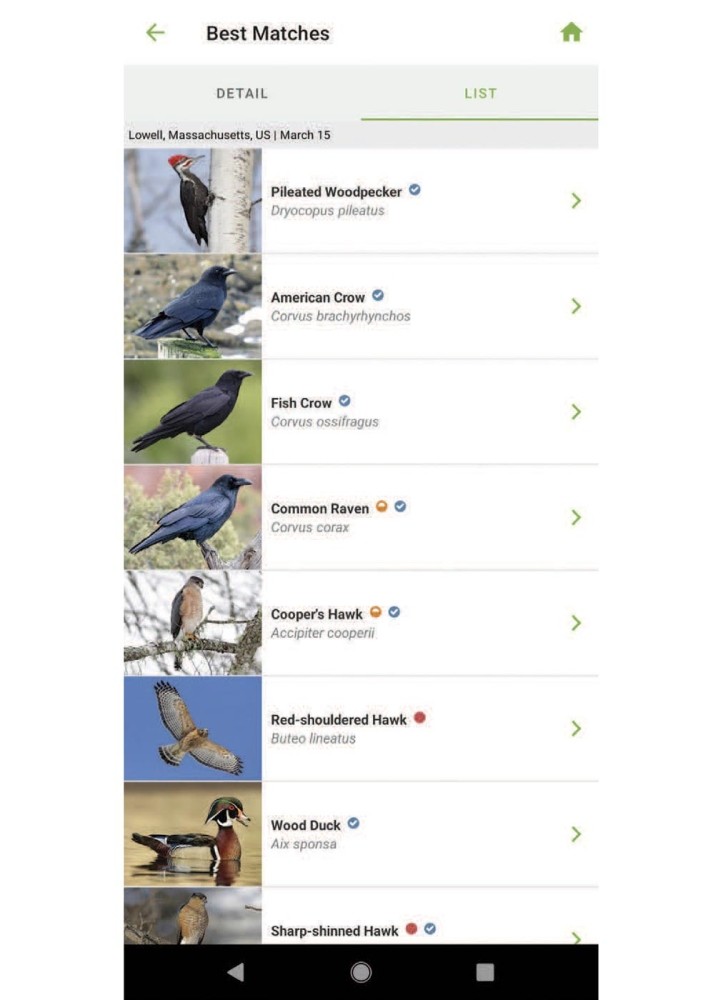
When you see an unfamiliar bird, do you reach for a book … or your smartphone? For many of us, it’s the latter. There’s a profusion of bird-identification apps available, but the one with the most clout is Merlin Bird ID, created and maintained by the Cornell Lab of Ornithology.
The core function of Merlin is the identification wizard, which prompts five simple questions about your mystery bird:
1) Where? You can use your phone’s internal GPS to answer this.
2) When?
3) Size? Choose from a seven-point scale of silhouettes from sparrow (smallest) to goose (largest).
4) What were the main colors? Choose up to three from a palette of nine.
5) What was the bird doing? Choose one: eating at a feeder, swimming or wading, on the ground, in trees or bushes, on a fence or wire, soaring or flying.
Feed these five data points into the app, and it spits out a list of likely candidates, with the “most likely” birds at the top. When it works – which is often – it really does seem like magic. By drawing on the mind-bogglingly huge database of bird sightings collected via Cornell’s eBird website (it passed one billion records in 2022) and applying a custom machine learning algorithm, the app can make predictions about which birds are most likely to be seen whenever and wherever you are.
The app’s suggestions, however, are inherently probabilistic, which means it’s all but useless when confronted with outliers: vagrant birds, pigment mutations (albinism, melanism, leucism), birds on the lam from the local zoo. It can also lead to some odd suggestions when its five points of data miss a decisive factor such as the small-scale habitat in which you’re standing. As an exercise, I told the app I’d seen a crow-size, black bird in a tree at my home in Lowell, Massachusetts … and its top suggestion was a pileated woodpecker. I’ve never seen this species in my urban neighborhood, but crows fly over daily (one cawed as I typed this). My guess is that the state forest – a few miles away, with a healthy population of pileated woodpeckers – is skewing the numbers.
Merlin Bird ID has several additional functions, including “Sound ID” via your phone’s mic and “Photo ID” via your camera or an uploaded image, both of which also hinge on machine learning and Cornell’s access to huge databases. Sound ID, in particular, can be extremely useful in the field – birdsong is difficult to transliterate (chickadee dee dee notwithstanding), and trying to look up an unfamiliar call without a point of reference can be a near impossibility.
There’s also an “Explore Birds” option, which generates an overall list of likely birds for your current location. And whenever the app suggests a species, you can tap that bird for more photographs, range maps, and sample calls. All useful and interesting information, to be sure.
Merlin’s real weakness is a consequence of its emphasis on wizardry. Like a true magician, it doesn’t reveal its methods; the internal logic used to choose and rank suggested birds based on your inputs is completely hidden. It’s designed to give you an answer, as quickly as possible, and with minimal effort. It doesn’t really help you learn how to identify birds.
For casual birders, this may be more than enough. But if you want to develop your skills as a birder, physical field guides are still indispensable. They let you browse. They present whole groups of birds at once to give you a sense of what sets them apart from one another. They’re full of useful annotations and advice from experts on what to look for when puzzling out an unfamiliar bird. Going birding with people more experienced than yourself is the fastest way to learn, and in the age of social media it’s easier than ever to find fellow birders and local bird walks, talks, or clubs.
Merlin is a handy tool in its own right – and easy to recommend to anyone interested – but it’s worth noting that it works best as a complement to a good field guide.

